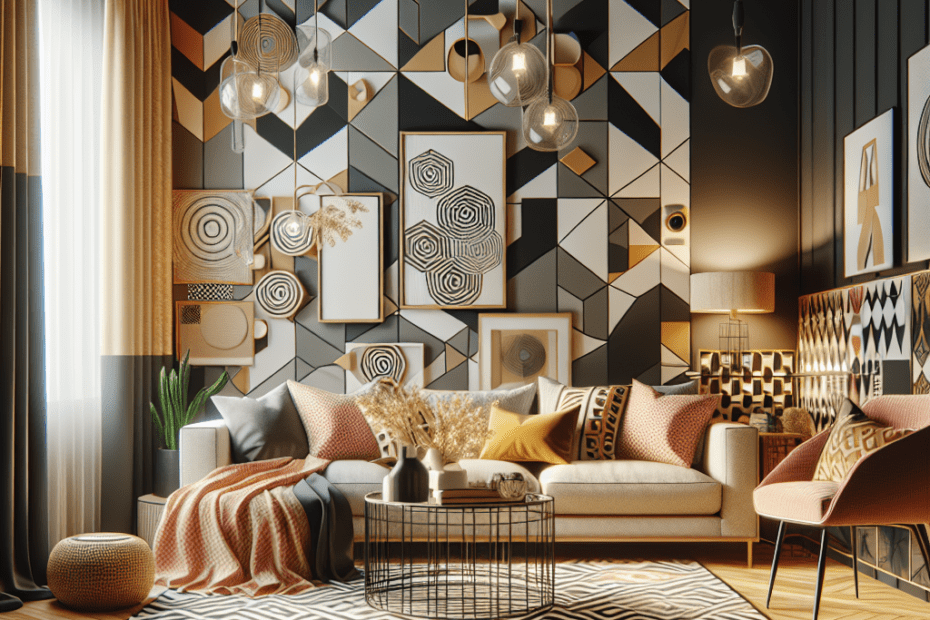“`html
Incorporating Geometric Patterns into Home Design
When it comes to revitalizing a living space, many people turn to geometric patterns in design for their versatility and timeless appeal. Geometric patterns can bring a fresh and dynamic aesthetic to any room, creating an atmosphere that feels both modern and classic. They might find inspiration in the clean lines and bold shapes that can be utilized in various home design elements such as walls, floors, furniture, and decorative accents.
With the increasing popularity of geometric patterns, it’s no surprise that research from Statista shows a 35% increase in online searches for geometric home decor over the past year. This trend underscores the potential impact of geometric patterns in creating visually striking and stylish homes.
Understanding Geometric Patterns in Design
Geometric patterns are composed of shapes like circles, triangles, squares, and polygons, repeated to create a regular or irregular form. These shapes can be symmetrical or asymmetrical, and they can appear in both two-dimensional and three-dimensional forms. They often find their applications in various aspects of home design, providing an intricate yet coherent visual language.
Designers frequently employ patterns not only to enhance aesthetic appeal but also to influence spatial perception. According to design experts, a room with geometric patterns can feel more organized and structured, as these patterns guide the eye and lead to a more efficient use of space.
Ways to Incorporate Geometric Patterns
Consider implementing geometric patterns in the following areas:
- Walls: Use wallpaper or paint stencils to create a striking geometric feature wall.
- Floors: Geometric tiles can add an artistic touch to bathrooms and kitchens.
- Furniture: Look for furniture pieces with geometric designs or add patterned cushions and throws.
- Decorative Accents: Incorporate items like geometric planters, rugs, or artwork to tie the room together.
Each of these areas provides an opportunity to introduce geometric patterns in a subtle or bold way, depending on personal taste and the overall design scheme of the home.
The Benefits of Geometric Patterns
Geometric patterns in design offer various benefits, including:
- Versatility: They can complement a range of styles, from minimalist to bohemian.
- Visual Interest: Patterns add depth and intrigue to any space, breaking up monotony.
- Illusion of Space: Certain patterns can make a room appear more spacious than it is.
- Focus and Balance: Geometric designs can define areas within open-plan settings, creating a sense of focus and balance.
Avoiding Overuse
While geometric patterns enhance a space, using them sparingly is crucial to avoid overwhelming the room. The key is to strike a balance, allowing patterns to accentuate rather than overpower. A good rule of thumb is to stick with one or two prominent geometric elements per room and use complementary patterns for smaller decorative items. By doing so, they can maintain a harmonious and visually pleasing environment.
Key Takeaways
- Geometric patterns in design are increasingly popular, adding both modern and timeless elements to home decor.
- These patterns can be incorporated into walls, floors, furniture, and decorative accents.
- The key advantages include versatility, visual interest, and the ability to influence spatial perception.
- A balanced approach is necessary to ensure patterns enhance rather than overwhelm the space.
| Application Area | Potential Geometric Pattern |
|---|---|
| Walls | Wallpaper, stencils |
| Floors | Ceramic tiles |
| Furniture | Patterned upholstery |
| Decorative Accents | Rugs, planters |
FAQs
- What are geometric patterns in design?
Geometric patterns involve the use of shapes like circles, triangles, and squares arranged in a repeated or consistent form. - Why are geometric patterns popular in home design?
They provide a modern, organized look that can make spaces feel fresh and visually interesting. - Where should they incorporate geometric patterns?
Walls, floors, furniture, and decorative items can all be enhanced with geometric designs. - Can geometric patterns make a room look bigger?
Yes, certain patterns can create the illusion of more space, making small rooms appear larger. - How should they balance geometric patterns in a room?
Limit to one or two prominent geometric elements per room with complementary smaller items to avoid overwhelming the space.
“`
